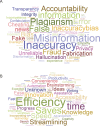An exploratory survey about using ChatGPT in education, healthcare, and research
- PMID: 37796786
- PMCID: PMC10553335
- DOI: 10.1371/journal.pone.0292216
An exploratory survey about using ChatGPT in education, healthcare, and research
Abstract
Objective: ChatGPT is the first large language model (LLM) to reach a large, mainstream audience. Its rapid adoption and exploration by the population at large has sparked a wide range of discussions regarding its acceptable and optimal integration in different areas. In a hybrid (virtual and in-person) panel discussion event, we examined various perspectives regarding the use of ChatGPT in education, research, and healthcare.
Materials and methods: We surveyed in-person and online attendees using an audience interaction platform (Slido). We quantitatively analyzed received responses on questions about the use of ChatGPT in various contexts. We compared pairwise categorical groups with a Fisher's Exact. Furthermore, we used qualitative methods to analyze and code discussions.
Results: We received 420 responses from an estimated 844 participants (response rate 49.7%). Only 40% of the audience had tried ChatGPT. More trainees had tried ChatGPT compared with faculty. Those who had used ChatGPT were more interested in using it in a wider range of contexts going forwards. Of the three discussed contexts, the greatest uncertainty was shown about using ChatGPT in education. Pros and cons were raised during discussion for the use of this technology in education, research, and healthcare.
Discussion: There was a range of perspectives around the uses of ChatGPT in education, research, and healthcare, with still much uncertainty around its acceptability and optimal uses. There were different perspectives from respondents of different roles (trainee vs faculty vs staff). More discussion is needed to explore perceptions around the use of LLMs such as ChatGPT in vital sectors such as education, healthcare and research. Given involved risks and unforeseen challenges, taking a thoughtful and measured approach in adoption would reduce the likelihood of harm.
Copyright: © 2023 Hosseini et al. This is an open access article distributed under the terms of the Creative Commons Attribution License, which permits unrestricted use, distribution, and reproduction in any medium, provided the original author and source are credited.
Conflict of interest statement
The authors report no conflicting interests.
Figures




Update of
-
An exploratory survey about using ChatGPT in education, healthcare, and research.medRxiv [Preprint]. 2023 Apr 3:2023.03.31.23287979. doi: 10.1101/2023.03.31.23287979. medRxiv. 2023. Update in: PLoS One. 2023 Oct 5;18(10):e0292216. doi: 10.1371/journal.pone.0292216. PMID: 37066228 Free PMC article. Updated. Preprint.
References
-
- Yang M. New York City schools ban AI chatbot that writes essays and answers prompts. The Guardian [Internet]. 2023. Jan 6 [cited 2023 Mar 27]; Available from: https://www.theguardian.com/us-news/2023/jan/06/new-york-city-schools-ba...
-
- Mollick E. All my classes suddenly became AI classes [Internet]. One Useful Thing. 2023. [cited 2023 Mar 27]. Available from: https://oneusefulthing.substack.com/p/all-my-classes-suddenly-became-ai
-
- Qadir J. Engineering Education in the Era of ChatGPT: Promise and Pitfalls of Generative AI for Education. In: 2023 IEEE Global Engineering Education Conference (EDUCON). 2023. p. 1–9.
-
- Baidoo-Anu D, Owusu Ansah L. Education in the Era of Generative Artificial Intelligence (AI): Understanding the Potential Benefits of ChatGPT in Promoting Teaching and Learning [Internet]. Rochester, NY; 2023. [cited 2023 Jun 27]. Available from: https://papers.ssrn.com/abstract=4337484
Publication types
MeSH terms
Grants and funding
LinkOut - more resources
Full Text Sources
Miscellaneous

